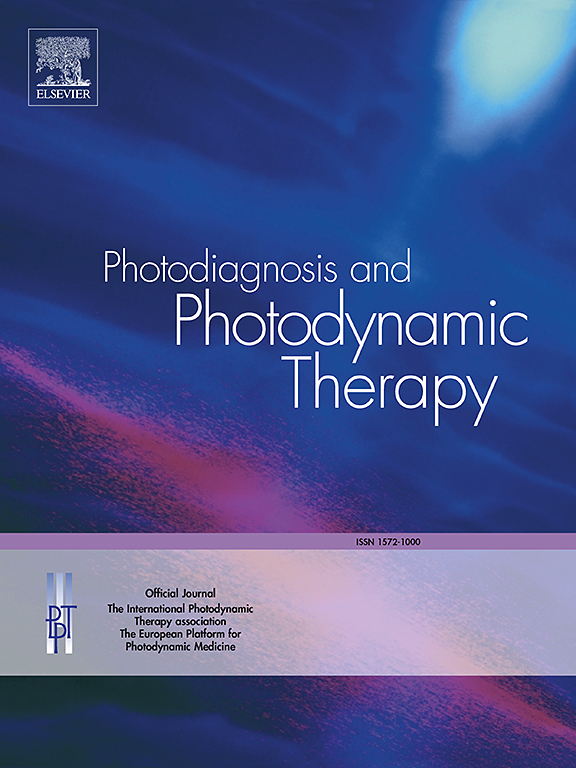优化声动力疗法和放疗增敏剂对lncRNA PVT1和miR-1204表达的影响克服乳腺癌治疗耐药
IF 3.1
3区 医学
Q2 ONCOLOGY
引用次数: 0
摘要
背景:声空化是超声治疗的基本机制,主要是由微泡破裂引起的惯性空化。声动力疗法,具有惯性声空化阈值和在致敏剂存在下的低剂量辐射,可能为癌症治疗提供显著效果,可能克服单一疗法遇到的耐药性。方法:将MCF7乳腺癌细胞单独或联合电离辐射、包被芹菜素的金纳米颗粒和亚甲基蓝进行声动力治疗。评估了几个参数,包括活性氧(ROS)的产生和定植。此外,研究还包括使用Real-Time PCR技术评估miRNA1204及相关基因的长链非编码RNA (lncRNA) PTV1。结果:声动力治疗力学指数为0.31时,声空化阈值使细胞内ROS增加。与对照组(98.77±4.49)和(97.59±2.94)相比,亚甲基蓝和金纳米粒子包覆芹菜素联合超声动力治疗和2Gy x射线照射显著降低了镀层效率(4.44±1.69)和存活率(2.75±1.98)。这与ROS显著增加相关,平均荧光强度为20576.2±4.6(>4.5倍)。联合治疗还增加了p53表达,降低了PVT1、miR-1204及相关基因的表达。结论:惯性声空化阈值下的声动力治疗,结合生物相容性纳米颗粒存在下的电离辐射,可以增强对乳腺癌中致癌microRNA miR-1204的治疗效果。miR-1204来源于lncRNA PVT1。这种方法有可能克服单一疗法所遇到的治疗耐药性。本文章由计算机程序翻译,如有差异,请以英文原文为准。
Overcoming breast cancer cell treatment resistance by optimizing sonodynamic therapy and radiation sensitizers on lncRNA PVT1 and miR-1204 expression
Background
Acoustic cavitation is a foundational mechanism in ultrasound therapy, primarily through inertial cavitation resulting from microbubble collapse. Sonodynamic therapy, with inertial acoustic cavitation threshold and low-dose radiation in the presence of sensitizers, may provide significant effects for cancer treatment, potentially overcoming resistance encountered with single therapies.
Methods
MCF7 breast cancer cells were subjected to sonodynamic therapy either alone or combined with ionizing radiation, gold nanoparticles coated with apigenin, and methylene blue. Several parameters were evaluated, including reactive oxygen species (ROS) generation and colonization. Additionally, the investigation included assessing the long non-coding RNA (lncRNA) PTV1 with miRNA1204 and related genes using Real-Time PCR.
Results
Sonodynamic therapy at a mechanical index of 0.31 as acoustic cavitation threshold increased intracellular ROS. Combining sonodynamic therapy and 2 Gy X-ray radiation with methylene blue and gold nanoparticles coated with apigenin significantly decreased plating efficiency (4.44±1.69), and survival fraction (2.75±1.98) compared with control (Ctrl.) (98.77±4.49) and (97.59± 2.94), respectively. This was associated with a marked increase in ROS with a mean fluorescence intensity of 20,576.2 ± 4.6 (>4.5 times). The combined treatment also increased p53 expression and decreased the expression of PVT1, miR-1204, and related genes.
Conclusion
Sonodynamic therapy in inertial acoustic cavitation threshold, combined with ionizing radiation in the presence of biocompatible nanoparticles, could enhance the therapeutic effects on the miR-1204, derived from lncRNA PVT1, that functions as an oncogenic microRNA in breast cancer. This approach has the potential to overcome treatment resistance encountered with single therapies.
求助全文
通过发布文献求助,成功后即可免费获取论文全文。
去求助
来源期刊

Photodiagnosis and Photodynamic Therapy
ONCOLOGY-
CiteScore
5.80
自引率
24.20%
发文量
509
审稿时长
50 days
期刊介绍:
Photodiagnosis and Photodynamic Therapy is an international journal for the dissemination of scientific knowledge and clinical developments of Photodiagnosis and Photodynamic Therapy in all medical specialties. The journal publishes original articles, review articles, case presentations, "how-to-do-it" articles, Letters to the Editor, short communications and relevant images with short descriptions. All submitted material is subject to a strict peer-review process.
 求助内容:
求助内容: 应助结果提醒方式:
应助结果提醒方式:


